Robotic pool cleaners have witnessed a surge in popularity due to their efficiency and convenience in maintaining pool cleanliness. These automated devices navigate pools autonomously, effectively removing debris and algae, thus reducing the need for manual cleaning. Their advanced filtration systems contribute to crystal-clear water, while their ease of use and low maintenance requirements make them a desirable option for pool owners seeking a hassle-free solution for pool upkeep.
Why is there a robot cleaning the pool?
Robotic pool cleaners have become a popular choice among pool owners for several reasons. These advanced devices offer a range of benefits that traditional pool cleaning methods and other types of automatic cleaners cannot match.
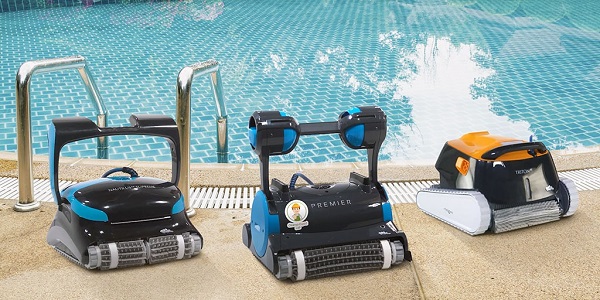
What makes robotic pool cleaners a must-have for pool owners?
Efficiency: Robotic pool cleaners are designed to thoroughly clean every inch of the pool, including the floor, walls, and waterline. They often have powerful suction capabilities and advanced brushes that can remove stubborn debris and algae.
Convenience: These cleaners are autonomous and require minimal supervision. Once set up, they can be programmed to clean the pool on a schedule, allowing pool owners to spend less time on maintenance.
Energy Savings: Unlike traditional suction or pressure-side cleaners, which rely on the pool’s filtration system and pump, robotic cleaners operate independently. This can result in significant energy savings and reduced wear and tear on the pool’s equipment.
Advanced Features: Many robotic cleaners come with smart features such as remote control, programmable cleaning cycles, and connectivity with smartphone apps. Some even have sensors that help them navigate and avoid obstacles, ensuring a more efficient cleaning process.
Water Conservation: By reducing the load on the pool’s filtration system, robotic cleaners help maintain better water circulation and clarity, potentially decreasing the need for frequent backwashing and water refills.
The Mechanisms and Technology Behind Robotic Pool Cleaners
Robotic pool cleaners operate using advanced technology that enables them to clean efficiently and autonomously. Here are some of the key mechanisms and technologies involved:
Motors and Drive Systems: Robotic cleaners are equipped with electric motors that power their movement and the cleaning brushes. These motors are designed to be energy-efficient and durable.
Brushes and Vacuum Systems: The cleaners have rotating brushes that scrub the pool surfaces to loosen dirt and debris. A powerful vacuum system then sucks up the debris into an onboard filter.
Navigation Systems: Advanced models use microprocessors and sensors to map the pool’s shape and size, ensuring comprehensive coverage. Some cleaners use gyroscopic technology or infrared sensors to avoid obstacles and optimize cleaning paths.
Filtration: Robotic cleaners have their own filtration systems that trap dirt and debris. These filters can be easily removed and cleaned, often featuring fine mesh or cartridge systems capable of capturing very small particles.
Power Supply and Cables: These cleaners are typically powered through a low-voltage transformer connected to a standard electrical outlet. They are connected to the power supply via a floating cable that prevents tangling and allows free movement.
Comparing Efficiency: Robotic vs. Traditional Pool Cleaners
| Feature | Robotic Cleaner | Traditional (Suction) Cleaner |
| Cleaning Coverage | Cleans all surfaces: floor, walls, waterline | Primarily cleans floors; may require a separate wall cleaner. |
| Automation | Fully automatic, pre-programmed cleaning cycles | Semi-automatic, requires connection to the pool pump, and may need hose adjustments. |
| Filtration | Built-in filter basket reduces load on the pool filtration system. | Relies on the pool’s filtration system and may require more frequent backwashing. |
| Energy Consumption | Lower energy use, separate pump | Run-off pool pump, potentially higher energy use |
| Maintenance | Requires emptying the filter basket and occasional part replacements. | It requires cleaning debris bags and checking hoses for leaks. |
| Upfront Cost | Higher initial cost | Lower initial cost |
Types and Features of Robotic Pool Cleaners
Robotic pool cleaners come in various types and models, each designed to cater to different pool sizes, shapes, and cleaning needs. Understanding these differences and key features can help you choose the best cleaner for your pool.
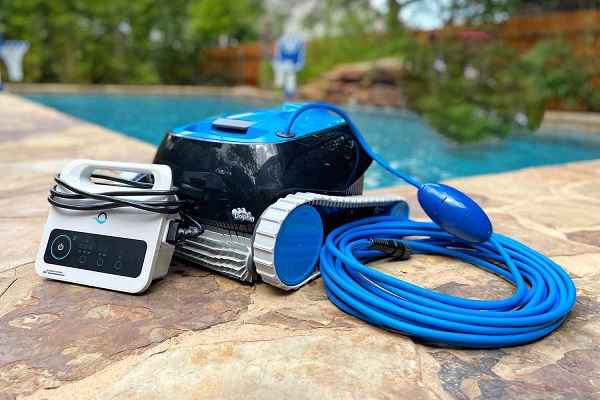
Understanding Different Types of Robotic Pool Cleaners
| Feature | Suction-Side Cleaner | Pressure-Side Cleaner | Electric (robotic) Cleaner |
| Power Source | Pool Pump | Dedicated Booster Pump | Internal Battery/Electric Cord |
| Movement | Suction from the pool pump | Pressure from the booster pump | Pre-programmed patterns, wheels, or tracks |
| Cleaning Coverage | Primarily, the floor , may require a separate wall cleaner. | Floor, some models climb walls. | Floor, walls, and waterline (depending on model) |
| Upfront Cost | Lower | Higher | Highest |
| Maintenance | Clean debris bags in the filter system and check hoses. | Clean the debris bag in cleaner and maintain the booster pump. | Empty filter basket, occasional part replacements |
| Automation | Requires connection to the pool pump and may require hose adjustments. | Requires plumbing for the booster pump. | Fully automatic, programmable cleaning cycles |
Key Features to Look for in a Robotic Pool Cleaner
1. Cleaning Coverage:
Wall and Waterline Cleaning: Ensure the cleaner can climb walls and scrub the waterline for a thorough clean.
Floor Coverage: Look for models that can cover the entire pool floor efficiently.
2. Filtration System:
Fine Particle Filtration: high-quality filters that can capture fine debris and particles, including sand and silt.
Easy to Clean: Filters should be easily removable and washable for convenience.
3. Brushes and Scrubbing Power:
Durable Brushes: Look for cleaners with strong, durable brushes that can remove algae and stubborn dirt.
Multiple Brush Types: Some models have a combination of brushes (e.g., rubber and bristle) for more effective cleaning.
4. Navigation and Mapping Technology:
Smart Navigation: Features like gyroscopic technology, infrared sensors, or advanced algorithms to ensure comprehensive and efficient cleaning.
Obstacle Avoidance: Ability to detect and avoid obstacles to prevent getting stuck.
5. Programmability and Automation:
Programmable Cleaning Cycles: Ability to set and schedule cleaning times and cycles.
Remote Control and App Connectivity: Some models offer remote control or smartphone app integration for ease of use and monitoring.
6. Energy Efficiency:
Low Energy Consumption: Look for energy-efficient models that reduce electricity costs.
7. Cable Length and Swivel Mechanism:
Adequate Cable Length: Ensure the cable is long enough to cover your entire pool.
Anti-Tangle Swivel: A swivel mechanism to prevent the cable from tangling during operation.
Top Models Reviewed: Finding the Perfect Fit for Your Pool Type
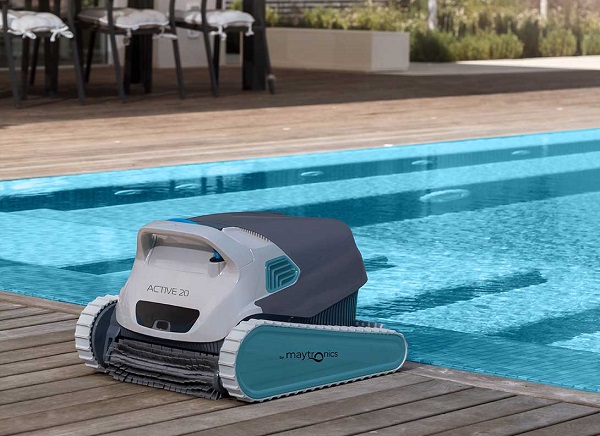
Dolphin Nautilus CC Plus:
- Best for in-ground pools: Known for its powerful cleaning capabilities and advanced navigation system,.
- Features: dual scrubbing brushes, large filter capacity, and programmable cleaning schedules.
- Pros: Efficient, reliable, and easy to use.
Polaris F9550 Sport:
- Versatile Option: Suitable for both in-ground and above-ground pools.
- Features: 4-wheel drive system, ActivMotion sensor technology, and remote control.
- Pros: excellent climbing ability, thorough cleaning, and energy- efficiency.
Aquabot X4:
- Great for Large Debris: Equipped with high-capacity filtration and durable scrubbing brushes.
- Features: intelligent navigation, anti-tangle swivel, and programmable cycles.
- Pros: superior debris handling, easy maintenance, and efficient operation.
Hayward TigerShark QC:
- Quick Clean Feature: Ideal for in-ground pools with a need for fast, efficient cleaning.
- Features: QuickClean cycle, powerful vacuum, and robust filtration system.
- Pros: fast cleaning, effective scrubbing, and reliable performance.
Aiper Smart AIPURY1500:
- Best for Budget: an affordable option with solid cleaning performance for above-ground pools.
- Features: compact design, simple operation, and efficient coverage.
- Pros: cost-effective, easy to use, and lightweight.
Robotic Pool Cleaner: Installation and Maintenance Guide
Robotic pool cleaners offer a convenient and thorough way to keep your pool sparkling clean. This guide will walk you through the installation process, provide regular maintenance tips, and help you troubleshoot common issues.
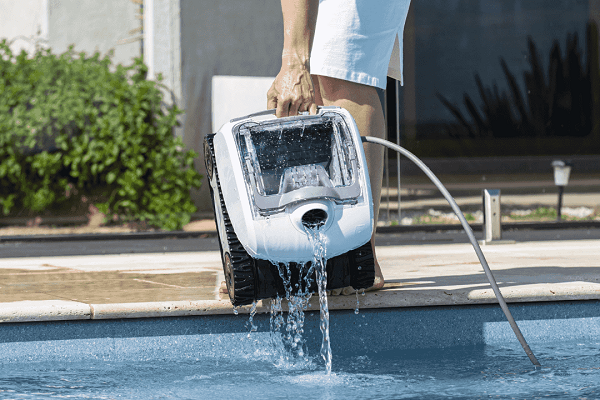
Easy Steps to Set Up Your Robotic Cleaner
Setting up a robotic pool cleaner is straightforward and can typically be done without professional assistance.
Unbox and inspect: Remove the cleaner and all its components from the box. Check for any damage or missing parts, including the power supply, cables, and filters.
Assemble the cleaner: Attach any brushes, rollers, or other parts that may need to be installed separately. Follow the manufacturer’s instructions carefully.
Connect the Power Supply: Place the power supply unit (PSU) in a location where it will not get wet and is close enough to reach an electrical outlet. Ensure the PSU is not exposed to direct sunlight or extreme temperatures.
Attach the Floating Cable: Connect the floating cable from the cleaner to the power supply unit. Make sure the connection is secure. Ensure the cable is untangled and can freely float in the pool.
Submerge the Cleaner: Gently lower the cleaner into the pool, allowing it to sink to the bottom. Shake the cleaner slightly to release any trapped air and ensure it sits flat on the pool floor.
Power On and Program: Plug the power supply into the electrical outlet and turn it on. Set the desired cleaning mode or schedule, following the instructions in the user manual. Many cleaners offer different cycles, such as quick clean or deep clean.
Monitor Initial Operation: Observe the cleaner’s initial operation to ensure it is moving correctly and covering the pool adequately. Adjust settings if necessary to optimize performance.
Regular maintenance tips and tricks
Clean the filter regularly.
Remove and clean the filter after each use, or as recommended by the manufacturer.
Rinse the filter with a hose to remove debris. For finer cleaning, soak the filter in a mild detergent solution and rinse thoroughly.
Check and clean brushes and tracks:
Inspect the brushes and tracks for wear and tear. Clean them to remove any accumulated dirt or algae.
Replace brushes or tracks if they show signs of significant wear.
Inspect the floating cable.
Check the cable for any signs of wear or damage. Ensure it is free from tangles and knots.
Store the cable properly when not in use to prevent damage.
Examine the power supply unit:
Ensure the PSU is kept dry and clean. Check for any damage to the cord or connections.
Store the PSU in a shaded, protected area when not in use.
Perform periodic deep cleaning.
Every few months, perform a more thorough cleaning of the cleaner, including scrubbing the exterior and internal components.
Inspect all parts for damage and replace any worn-out components.
Winterize the cleaner:
If you live in an area with cold winters, store the cleaner indoors during the off-season.
Drain all the water from the cleaner to prevent freezing and potential damage.
Dealing with Common Issues and Troubleshooting

1. The cleaner is not moving.
- Check Power Supply: Ensure the PSU is plugged in and turned on. Verify that the electrical outlet is functioning.
- Inspect Connections: Ensure all cable connections are secure and the floating cable is not damaged.
- Reset the Cleaner: Turn off the power supply, wait a few minutes, and turn it back on.
2. The cleaner is moving but not cleaning properly.
- Clean the filter: A clogged filter can reduce suction power. Clean or replace the filter as needed.
- Inspect brushes: Check if the brushes are worn out or obstructed by debris. Clean or replace them if necessary.
- Check Intake Ports: Ensure the intake ports are not blocked by large debris.
3. Cleaner Gets Stuck:
- Check for Obstacles: Remove any large debris or obstacles in the pool that could impede the cleaner’s movement.
- Inspect Tracks and Wheels: Ensure the tracks and wheels are functioning properly and are not jammed.
- Adjust Cleaning Cycle: Try a different cleaning cycle or mode that may navigate the pool better.
4. Cleaner is Not Climbing Walls:
- Brush Condition: Ensure the brushes are in good condition and suitable for wall cleaning.
- Water Chemistry: Check the pool’s water chemistry. Imbalanced water can affect the cleaner’s ability to climb.
- Adjust Floats: Some models have adjustable floats that help with climbing. Check the user manual for adjustments.
5. Floating Cable Tangling:
- Swivel Mechanism: Ensure the anti-tangle swivel mechanism is functioning properly.
- Spread Out Cable: Spread the cable out fully in the pool before starting the cleaner to reduce tangling.
Cost and Benefit Analysis of Robotic Pool Cleaners
Cost Analysis: Investing in a Robotic Pool Cleaner vs. Professional Pool Cleaning Services
| Feature | Robotic Pool Cleaner | Professional Pool Cleaning Services |
| Initial Investment | Cost Range: $500 to $1,500 for high-quality models.Upfront Cost: Typically a one-time expense. | Cost per visit: $75 to $150, depending on pool size and service complexity.Annual Cost: Assuming bi-weekly visits, the annual cost ranges from $1,950 to $3,900. |
| Operational Costs | Electricity: low energy consumption, averaging $0.05 to $0.20 per cleaning cycle.Maintenance and Parts: Approximately $100 to $200 per year for filter replacements and minor repairs. | None: Operational costs are included in the service fee. |
| Long-Term Costs (5 Years) | Total Initial Investment: $500 to $1,500.Total Operational Costs: $500 to $1,000 (electricity and maintenance).Total Cost: $1,000 to $2,500 over 5 years. | Total Cost: $9,750 to $19,500 over 5 years. |
Why are robotic pool cleaners Cost-Effective in the long run?

While the upfront cost of a robotic cleaner is higher than that of a single professional cleaning, robotic cleaners can be more cost-effective in the long run.
1. Lower Long-Term Costs:
- Significant Savings: The total cost of owning a robotic pool cleaner over five years is significantly lower than the cumulative cost of professional cleaning services. Even with maintenance and occasional part replacements, robotic cleaners present substantial savings.
2. Energy Efficiency:
- Low Energy Consumption: Robotic cleaners are designed to be energy-efficient, often consuming less power than traditional pool pumps and filtration systems. This translates to lower electricity bills compared to the energy costs associated with running pool equipment needed for professional cleaning services.
3. Reduced wear and tear on pool equipment:
- Independent Operation: Robotic cleaners operate independently of the pool’s filtration system, reducing the strain on pool pumps and filters. This can extend the lifespan of the pool’s equipment and lower repair and replacement costs.
4. Minimal Maintenance Costs:
- Affordable Upkeep: Routine maintenance for robotic cleaners, such as cleaning or replacing filters and brushes, is relatively inexpensive. These tasks can be performed by the pool owner, eliminating the need for costly service visits.
5. Time Savings:
- Convenience: Robotic pool cleaners automate the cleaning process, freeing up time for pool owners. This convenience factor is a significant benefit compared to scheduling and waiting for professional cleaners.
6. Improved Pool Hygiene and Longevity:
- Frequent Cleaning: Robotic cleaners can be scheduled to clean the pool as often as needed, ensuring consistently clean and well-maintained water. This frequent cleaning helps maintain balanced water chemistry and reduces the likelihood of algae growth, extending the overall lifespan of the pool.
7. Environmental Benefits:
- Water Conservation: By reducing the load on the pool’s filtration system, robotic cleaners help maintain better water quality and clarity, potentially decreasing the need for frequent backwashing and water refills, leading to water conservation.
8. Increased Property Value:
- Well-Maintained Pool: A clean and well-maintained pool enhances the aesthetic appeal of a property, potentially increasing its market value. Prospective buyers often view automated pool maintenance as a desirable feature.
Environmental Impact of Robotic Pool Cleaners
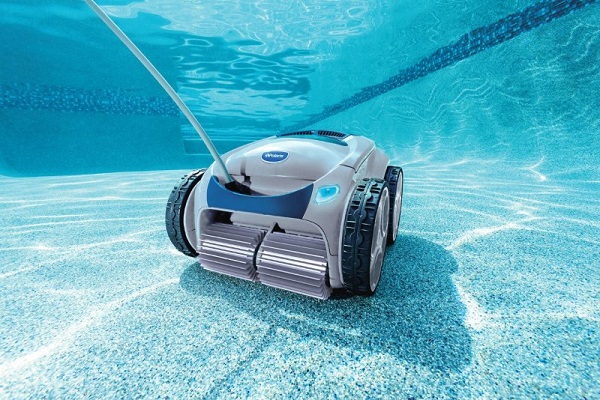
How eco-friendly are robotic pool cleaners?
Robotic pool cleaners are considered to be more environmentally friendly compared to traditional cleaning methods and other types of automatic pool cleaners.
1. Energy Efficiency:
Low Energy Consumption: Robotic pool cleaners are designed to operate using minimal electricity. They use efficient motors that consume significantly less power compared to the pool’s main filtration system and pump.
Independent Operation: Unlike suction-side or pressure-side cleaners that rely on the pool’s pump and filtration system, robotic cleaners have their own power source, reducing the overall energy usage of the pool’s equipment.
2. Water Conservation:
Reduced Backwashing: By efficiently removing debris and maintaining cleaner water, robotic pool cleaners reduce the need for frequent backwashing of the pool filter, which can save a considerable amount of water.
Less Chemical Use: Cleaner water with fewer contaminants reduces the demand for additional chemicals, like chlorine and algaecides, contributing to a lower chemical footprint.
3. Lower Carbon Footprint:
Minimal Emissions: The electricity consumed by robotic cleaners results in lower carbon emissions compared to the fuel consumption and emissions from service vehicles used by professional cleaning services.
Sustainable Materials: Many modern robotic cleaners are built with durable and recyclable materials, which can contribute to reduced environmental impact over their lifecycle.
4. Reduction in Pool Equipment Wear and Tear:
Extended Equipment Life: Robotic cleaners help to extend the life of the pool’s pump and filtration system by reducing their usage, which can lower the frequency of replacements and associated manufacturing impacts.
Assessing the energy consumption of robotic pool cleaners
Understanding the energy consumption of robotic pool cleaners can provide insights into their efficiency and environmental benefits. Here’s a closer look:
1. Energy Usage:
Typical Consumption: Most robotic pool cleaners consume between 100 and 200 watts per hour. This is relatively low compared to the energy usage of a pool pump, which can range from 1,000 to 2,000 watts per hour.
Operational Time: Robotic cleaners generally operate for 2 to 4 hours per cleaning cycle. Assuming an average of 3 hours per cycle and using a cleaner three times a week, the weekly energy consumption would be:
Energy per week=200 watts×3 hours×3 days=1,800 watt-hours=1.8 kWh
Energy per week=200 watts×3 hours×3 days=1,800 watt-hours=1.8 kWh
Over a month (4 weeks), the total would be:
Energy per month = 1.8 kWh×4 = 7.2 kWh
Energy per month = 1.8 kWh×4 = 7.2 kWh
2. Cost of Operation:
Electricity Costs: Assuming an average electricity cost of $0.13 per kWh, the monthly cost of operating the robotic cleaner would be:
Monthly cost=7.2 kWh×$0.13=$0.94
Monthly cost=7.2 kWh×$0.13=$0.94
This is a minimal cost compared to the savings from reduced use of pool pumps and professional cleaning services.
3. Comparison with Traditional Methods:
Pool Pumps: A typical pool pump running for 8 hours a day at 1,500 watts would consume:
Daily consumption = 1,500 watts × 8 hours = 12,000 watt-hours = 12 kWh.
Daily consumption = 1,500 watts × 8 hours = 12,000 watt-hours = 12 kWh.
Monthly consumption = 12 kWh/day×30 days = 360 kWh
Monthly consumption = 12 kWh/day×30 days = 360 kWh
This results in significantly higher energy usage compared to robotic cleaners.
4. Environmental Impact of Reduced Chemical Use:
Cleaner Water Quality: By maintaining cleaner water, robotic cleaners reduce the need for frequent chemical treatments. Fewer chemicals in the pool lead to less environmental runoff and lower pollution levels in local water sources.
5. Tips for Reducing Carbon Footprint:
- Optimize Cleaning Cycles: Run the cleaner only as often as necessary based on pool usage and debris levels.
- Solar Power: Consider using solar panels to generate electricity for the pool cleaner, significantly reducing the reliance on the main grid.
- Energy-Efficient Models: Look for models with features like automatic shut-off and energy-saving cleaning patterns.
- Proper Maintenance: Regularly clean filters and brushes to ensure optimal performance and minimize energy use during cleaning cycles.
Technological Advances in Robotic Pool Cleaners

AI and Machine Learning Enhancements
Artificial intelligence (AI) and machine learning (ML) are revolutionizing the capabilities of robotic pool cleaners, making them smarter, more efficient, and more user-friendly.
1. Advanced Navigation and Mapping:
AI-Powered Navigation: Modern robotic pool cleaners use AI algorithms to map out the pool’s layout. This allows the cleaner to navigate more efficiently, ensuring comprehensive coverage without missing spots or repeating the same area.
Obstacle Detection and Avoidance: AI enables the cleaner to detect and avoid obstacles, such as pool toys or irregular surfaces, reducing the risk of getting stuck and improving overall cleaning performance.
2. Adaptive Cleaning Patterns:
Learning Algorithms: Machine learning algorithms allow the cleaner to adapt its cleaning patterns based on the pool’s specific characteristics. Over time, the cleaner learns the most efficient routes and methods for the particular pool, optimizing cleaning cycles and reducing energy consumption.
Customized Cleaning Modes: AI can adjust the cleaning intensity and focus on areas that need more attention, such as spots with high debris accumulation, ensuring a more thorough and efficient cleaning.
3. Predictive Maintenance:
Self-diagnosis: AI enables robotic pool cleaners to perform self-diagnosis, identifying potential issues before they become serious problems. This helps in maintaining optimal performance and extending the device’s lifespan.
Maintenance Alerts: Users can receive alerts for necessary maintenance tasks, such as filter cleaning or brush replacement, based on the cleaner’s usage and detected wear and tear.
Remote Control and Automation Features with Smart Home Systems
Integration with smart home systems and enhanced remote control features have made robotic pool cleaners more convenient and easy to use.
1. Smartphone Apps:
Remote Operation: Users can control their robotic pool cleaner remotely through dedicated smartphone apps. This includes starting, stopping, and scheduling cleaning cycles, as well as adjusting settings from anywhere.
Real-Time Monitoring: Apps provide real-time updates on the cleaner’s status, progress, and any issues that may arise. Users can monitor cleaning performance and make adjustments as needed.
2. Voice Control:
Smart Assistant Integration: Many robotic pool cleaners are now compatible with popular smart home assistants like Amazon Alexa and Google Assistant. This allows users to control the cleaner using voice commands, adding a layer of convenience.
Routine Integration: Users can include the pool cleaner in their daily routines or smart home automation sequences. For example, you can set a routine to clean the pool at specific times or in conjunction with other smart home activities.
3. Automation and Scheduling:
Flexible Scheduling: Advanced scheduling features allow users to set up multiple cleaning schedules tailored to their needs. For example, different schedules can be set for weekdays and weekends, or for different seasons.
Automatic Adjustments: Some robotic cleaners can automatically adjust their cleaning schedules based on weather conditions or pool usage patterns, optimizing performance and energy use.
4. Enhanced Connectivity:
Wi-Fi and Bluetooth: Wi-Fi and Bluetooth connectivity enable seamless communication between the cleaner and the user’s smartphone or smart home system, ensuring smooth operation and easy updates.
Firmware Updates: Manufacturers can roll out firmware updates to improve the cleaner’s functionality, fix bugs, and add new features, keeping the device up-to-date with the latest advancements.
Choosing the Right Robotic Pool Cleaner
Selecting the perfect robotic pool cleaner requires considering several factors to ensure it effectively cleans your pool and complements your lifestyle.
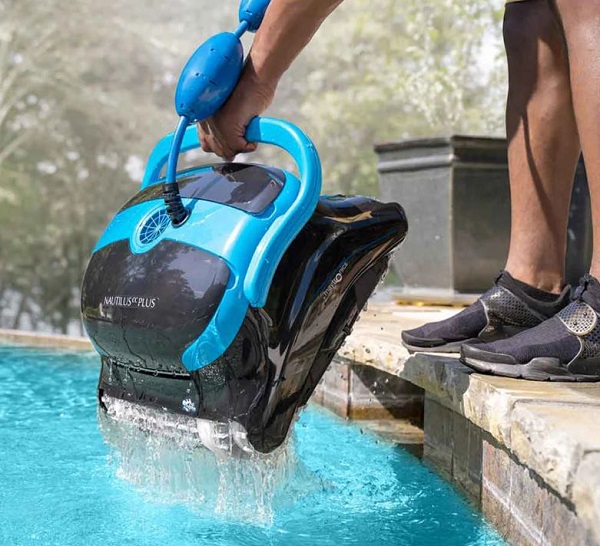
How to Choose the Best Robotic Pool Cleaner for Your Needs
Selecting the best robotic pool cleaner involves considering several factors tailored to your specific pool and preferences. Here’s a guide to help you make an informed decision:
1. Pool size and shape:
Size: Ensure the cleaner is suitable for the size of your pool. Larger pools may require cleaners with longer cables and more powerful motors.
Shape: Irregularly shaped pools with features like steps, ledges, and curves may benefit from models with advanced navigation and climbing capabilities.
2. Types of debris:
Fine Particles vs. Large Debris: Some cleaners are better at handling fine particles (like sand and silt), while others are designed for larger debris (like leaves and twigs). Choose a model based on the predominant type of debris in your pool.
3. Surface Material:
Vinyl, fiberglass, tile, and concrete: Different surfaces may require different types of brushes. Ensure the cleaner you choose is compatible with your pool’s surface material to avoid damage and ensure effective cleaning.
4. Features and Technology:
Navigation and Mapping: Advanced models with AI and machine learning offer better navigation and efficiency.
Filter Types: Consider the type of filter the cleaner uses (e.g., fine mesh for small particles or standard filters for general debris).
Cleaning Cycles: Look for models offering various cleaning cycles and modes (e.g., quick clean, deep clean, waterline cleaning).
5. Energy Efficiency:
Low Power Consumption: Opt for models that are energy-efficient to save on electricity costs and reduce your carbon footprint.
6. Ease of Use:
Remote Control and App Integration: Models with smartphone apps or remote control can offer greater convenience.
Maintenance: Check how easy it is to clean and maintain the unit, including filter cleaning and brush replacement.
7. Budget:
Initial Cost vs. Long-Term Savings: While higher-end models may be more expensive initially, they often provide better efficiency and durability, resulting in long-term savings.
Detailed Instructions on the Installation and Setup of a Robotic Pool Cleaner
1. Unboxing and Inspection:
Unpack the Cleaner: Remove the cleaner and all components from the box. Inspect for any damage or missing parts.
Check the manual: Read the user manual for specific instructions related to your model.
2. Assembly:
Attach Brushes and Filters: If required, attach brushes, rollers, and filters as per the manual.
3. Power Supply Placement:
Position the PSU: Place the power supply unit (PSU) at a dry location, near a power outlet, and within reach of the pool.
Ensure Safety: Keep the PSU away from direct sunlight and water exposure.
4. Connecting the cable:
Attach the cable. Connect the floating cable from the cleaner to the PSU. Ensure a secure connection.
Check for Tangles: Ensure the cable is untangled and free to move in the pool.
5. Submerging the Cleaner:
Lower the Cleaner: Gently place the cleaner into the pool, allowing it to sink to the bottom.
Release Trapped Air: Shake the cleaner slightly underwater to release any trapped air bubbles.
6. Powering On and Programming:
Turn on the PSU: Plug the PSU into the electrical outlet and turn it on.
Set Cleaning Mode: Use the control panel on the PSU or the smartphone app to select the desired cleaning mode and schedule.
7. Monitoring Initial Operation:
Observe Performance: During the first run, monitor the cleaner to ensure it moves correctly and covers the entire pool.
Adjust Settings if Needed: Make any necessary adjustments to the settings to optimize cleaning.
Comparing Brands and Models
1. Dolphin (Maytronics):
Popular Models: Dolphin Nautilus CC Plus, Dolphin Premier.
Features: Known for advanced navigation, powerful suction, and energy efficiency. Models often include smart features like weekly timers and app control.
2. Polaris:
Popular Models: Polaris F9550 Sport, Polaris 9650iQ Sport.
Features: high performance with Vortex vacuum technology, Wi-Fi connectivity, and easy lift systems. Suitable for large and complex pool shapes.
3. Aquabot:
Popular Models: Aquabot Elite, Aquabot Breeze IQ.
Features: Strong emphasis on fine filtration and energy efficiency. Often more affordable with good cleaning performance for residential pools.
4. Hayward:
Popular Models: Hayward TigerShark, Hayward AquaVac 650.
Features: robust build quality with effective cleaning cycles and smart navigation. Some models offer advanced app control and remote operation.
5. iRobot Mirra:
Popular Models: iRobot Mirra 530.
Features: high-quality cleaning with a focus on fine debris. User-friendly with easy maintenance.
Conclusion
Robotic pool cleaners offer numerous benefits, including superior cleaning performance, reduced chemical usage, and increased time for leisure. Their efficient operation eliminates the need for manual scrubbing, ensuring a sparkling pool with minimal effort. Integrating a robotic cleaner into your maintenance routine streamlines the process, freeing up your valuable time while ensuring a pristine aquatic environment.

Meet David Thomas, a seasoned professional with nearly 8 years of experience specializing in inspecting and resolving issues related to swimming pools. With his expertise and meticulous attention to detail, David ensures the safety and functionality of pools, making them a refreshing oasis for all to enjoy. Whether it’s troubleshooting equipment or maintaining water quality, David’s proficiency guarantees top-notch solutions tailored to meet every pool owner’s needs.
